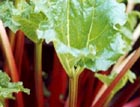Cultivating Christmas Cheer
The month of December in the walled garden of Swinton Park brings Jerusalem artichokes, brussels sprouts, forced rhubarb and Christmas decorations.


December 8, 2005The treat for December is the digging of the Jerusalem artichokes. They are grown in their own corner of the garden and left to get on with it during the summer. They get a mulch with manure every few years in the spring. In the autumn, the tall stems are cut down; then, as they are dug up, one medium tuber is immediately replanted. This will grow and provide next year's crop. The only problem is that the pheasants are also very fond of these artichokes, so I have to net them. The pheasants also like tulips, which are grown in the same area so one large net will cover them all.
I always hope that pheasants eat slugs as that would be their only redeeming feature in the garden.
I only grow late varieties of Brussels sprouts as one can easily get tired of them if they start too soon in the winter. There are some good varieties of red sprouts available now, and they get better as it gets colder. Red cabbage and kale are also proper winter vegetables and come into their own this month. The winter salad leaves are a real treatcorn salad, endive, American land cress and claytonia are some of my favourites.
This is the month when I cover the seakale and rhubarb crowns to force them. I use black plastic muck-buckets for the rhubarb as they are larger than normal buckets, but the latter are adequate for the seakale. I cover the buckets with sheep's fleece to provide some insulation as a result they do look uncannily like sheep!
At the beginning of the month, we start to decorate the hotel for Christmas. It is amazing what you can do with a can of spray paint and dried seedheads and leaves from the garden. Cardoon flowers and any globe artichokes that have come out too far to be used in the kitchens can be hung to dry, then turned red, silver or gold.
I grow some eucalyptus trees in the picking garden, which I keep pollarded for greenery. Dried, these mature leaves look particularly spectacular when sprayed gold they go very well in a vase with white lilies. Dried hydrangea heads and allium seed heads are also excellent subjects for spraying. I use florists' Oasis to make the best sprays. Silver birch, branches and even trees look great when sprayed white and decorated with fairy lights. These have the added bonus of lasting for years, and you have no pine needles on the floor.
One of the difficulties in a centrally heated house is getting natural material to last for any length of time, so I stand evergreen branches in a glycerine solution (one part glycerine to three parts hot water) for about a week before I use them. This works particularly well with holly. The leaves do go brown eventually, but keep their shine. The berries don't keep their colour so well, so I have some false berries which I attach. The glycerined holly branches will last for more than a year.
Exquisite houses, the beauty of Nature, and how to get the most from your life, straight to your inbox.
Although the fresh holly doesn't last in the house, it is fine outside, and I think that there is nothing to beat a Christmas wreath made with well berried holly. I get a wreath base from the florist, then use a reel of binding wire to bind the holly branches round onto the base. I then cut off any tips of branches or leaves that are obscuring the berries. A large bow of red florists' ribbon attached at the top of the wreath finishes it off, and is quite weatherproof. A wreath like this will last for about a month outside.
Chef's tip: Jerusalem artichokes are very good roasted with the addition of garlic, thyme, rock salt and shallots. Use in place of roast potatoes. They also make a very good velouté. Swinton Park hotel and restaurant:www.swintonpark.comor contact 01765 680900
Next week, In My Garden comes from Oxford, where Mark Griffiths will be pondering the best shrubs for winter fragrance.
This article first appeared in COUNTRY LIFE magazine on December 8, 2005. To subscribe, click below.
Country Life is unlike any other magazine: the only glossy weekly on the newsstand and the only magazine that has been guest-edited by His Majesty The King not once, but twice. It is a celebration of modern rural life and all its diverse joys and pleasures — that was first published in Queen Victoria's Diamond Jubilee year. Our eclectic mixture of witty and informative content — from the most up-to-date property news and commentary and a coveted glimpse inside some of the UK's best houses and gardens, to gardening, the arts and interior design, written by experts in their field — still cannot be found in print or online, anywhere else.
